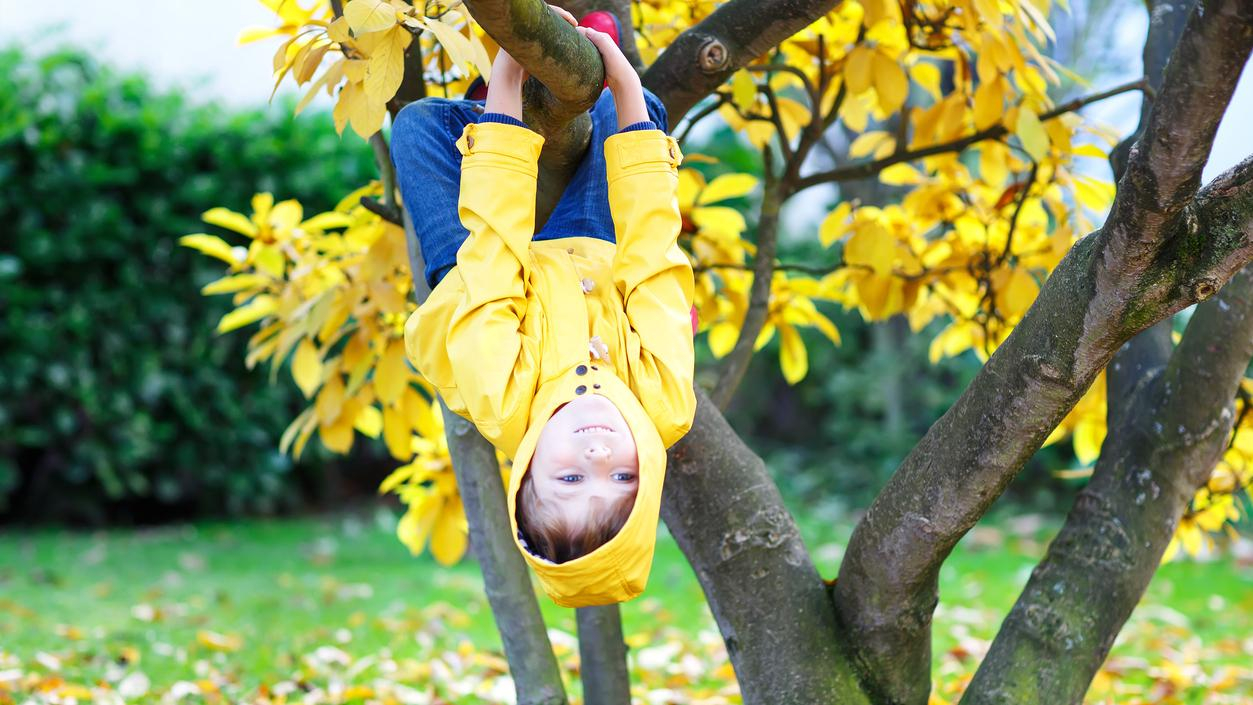Six Intentional Teaching Strategies to Promote Adventurous Play
- Written by: Dr. Lynne Lafave

Balancing child safety with challenging physical exploration puts adventurous play in a tricky realm. The competing perspectives can leave us unsure of what to do. Does this sound familiar?
“I used to be directed by my inner fears and tended to interfere in the activity when I saw a child doing risky things in his/her play such as sliding fast or getting close to dangerous places.“ 1
Health Benefits of Adventurous Play
Engaging in adventurous play offers numerous health benefits for children. But what is adventurous play? Adventurous play (or risky play) is any thrilling type of play that carries some potential for physical injury. Researchers have identified six different types: play at great heights, high speed, dangerous tools, dangerous elements, rough and tumble, and getting lost.2
It supports children in developing essential physical and motor skills, such as balance, coordination, and strength, as they navigate challenging environments and activities. It fosters a deep sense of body awareness, allowing children to better understand their physical limits and capabilities.3 It also enhances mental and emotional well-being by boosting self-confidence and resilience.
One key benefit of adventurous play is how it empowers children to assess and manage risk. Practicing with challenging environments within a play context helps children develop risk-competence through social learning, spatial awareness, motor development, and increased ability to manage failures, leading to coping mechanisms for self-reliance.4
Educators as Adventurous Play Advocates
Outdoor Play Canada suggests that educators and caregivers actively embrace the outdoors for learning, socialization and physical activity opportunities, in various weather conditions— including rain and snow.5 Their position is that adventurous outdoor play should be a priority within childcare centre experiences.5
Educators have an important role in supporting children’s adventurous play. In fact, an intentional teaching approach to support children's learning in outdoor adventurous environments can increase children’s engagement in adventurous play.6
“I don’t really understand how we can grow as human if we don’t take risks. It is built into the natural evolution of a person’s development—its apart of every step of developing.” 7
Adventurous Play Intentional Teaching Strategies
So how can educators engage in an intentional teaching approach to supporting adventurous play? Kate Higginbottom and her team (2023) developed a list of strategies that early childhood education and care teachers can use to promote and support adventurous play.6
1) Sustained shared thinking: Groups of children and/or educators use a series of questions and/or statements to solve problems and co-construct workable knowledge for perceiving, managing and assessing risks in their play.
2) Challenge: Educators support children to try their physical limits within comfort and verbalize their thinking about risky play actions in a collaborative approach.
3) Invite participation: Educators invite children to participate in a range of risky play experiences likely to provide opportunities for developing risk assessment and management skills.
4) Praise and celebrate: Educators express admiration and celebration for children’s decisions, actions and/or achievements involving risky play.
5) Promote peer collaboration: Educators encourage children to work in collaboration with peers when problem-solving or working towards a common goal involving risky play decision-making
6) Support and guide: Educators provide verbal and physically appropriate support and guidance to children as required to support participation in risky play activities
For Reflection
- What experiences are provided at your site to promote children’s active engagement both indoors and out?
- How do you plan for physical challenges at your centre?
Key Takeaways
- Adventurous play is a powerful catalyst for children's growth and development, offering numerous physical, mental, and emotional benefits.
- Early childhood educators have a pivotal role in promoting and facilitating adventurous play, an essential tool for child development.
- Consider reflecting on your professional practice and ways in which you might incorporate one or more of the intentional teaching strategies that can help you promote adventurous play in your child care centre.
References
- Cevher-Kalburan, N. (2015). Developing pre-service teachers’ understanding of children’s risky play. Journal of Adventure Education and Outdoor Learning, 15(3), 239-260.
- Sandseter, E. B. (2007). Categorising risky play—how can we identify risk‐taking in children's play?. European Early Childhood Education Research Journal, 15(2), 237-252.
- Brussoni, M., Gibbons, R., Gray, C., Ishikawa, T., Sandseter, E. B. H., Bienenstock, A., ... & Tremblay, M. S. (2015). What is the relationship between risky outdoor play and health in children? A systematic review. International journal of environmental research and public health, 12(6), 6423-6454.
- Little, H., Sandseter, E. B. H., & Wyver, S. (2012). Early childhood teachers' beliefs about children's risky play in Australia and Norway. Contemporary issues in early childhood, 13(4), 300-316.
- Tremblay, M. S., Gray, C., Babcock, S., Barnes, J., Bradstreet, C. C., Carr, D., ... & Brussoni, M. (2015). Position statement on active outdoor play. International journal of environmental research and public health, 12(6), 6475-6505.
- Higginbottom, K., Newman, L., West-Sooby, K., & Wood, A. (2023). Intentional Teaching for Risky Play: Practitioner Researchers Move Beyond Their Comfort Zones. Australasian Journal of Early Childhood, 48(1), 18-33. https://doi-org.libproxy.mtroyal.ca/10.1177/18369391221112740
- Harper, N. J., & Obee, P. (2021). Articulating outdoor risky play in early childhood education: voices of forest and nature school practitioners. Journal of Adventure Education and Outdoor Learning, 21(2), 184-194.